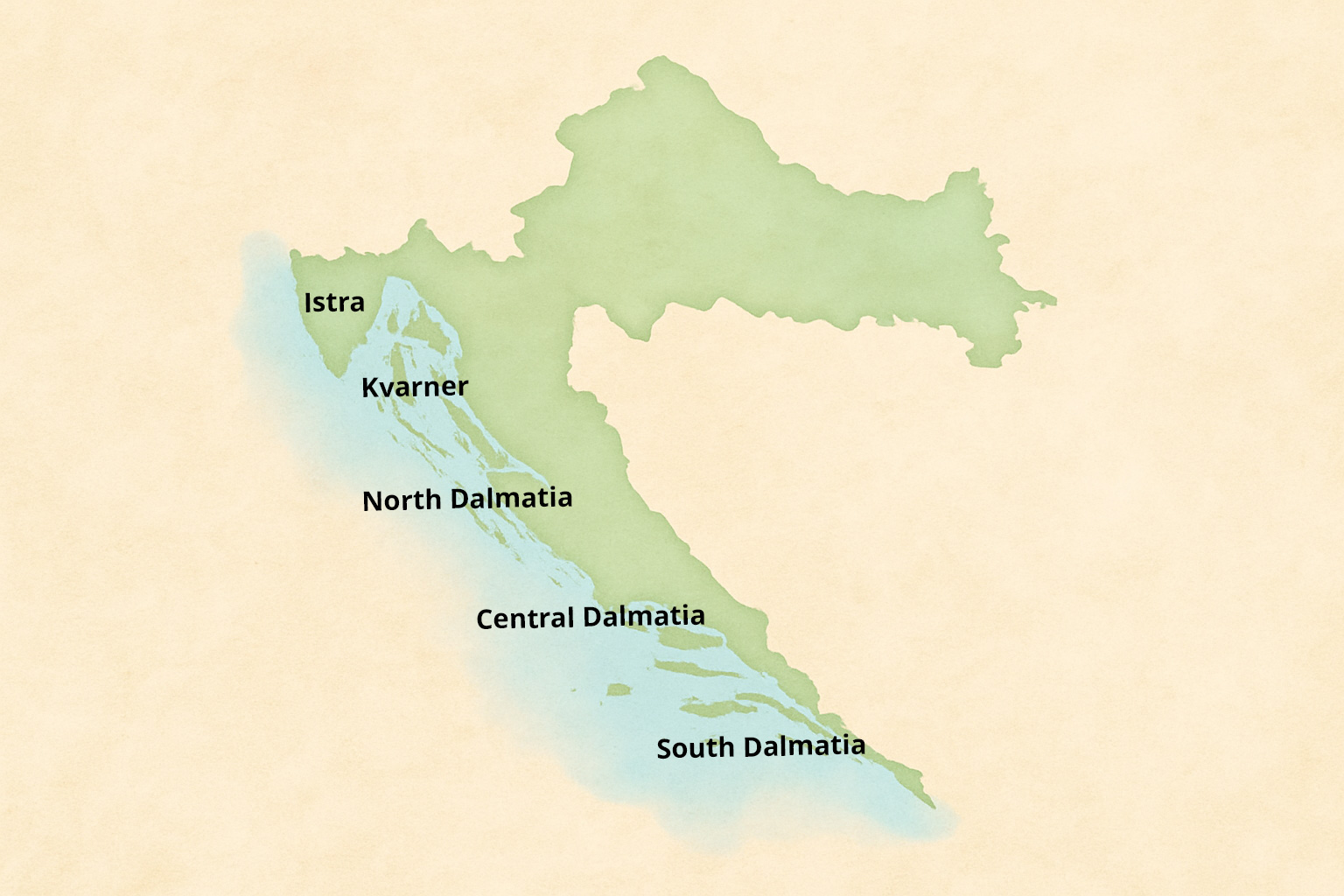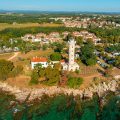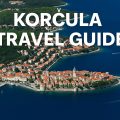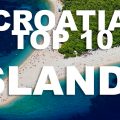Dreaming of Croatia? Discover which stretch of the stunning Adriatic coast fits your travel style—from party towns to peaceful island escapes.
Table of Contents
One look at the map, though, and it can feel overwhelming — where do you even begin with nearly 6,000 km of beautifully indented Adriatic coast to choose from? From the historical charm of Istria, through the Kvarner Gulf nestled beneath the majestic Velebit Mountains, all the way down to laid-back Dalmatia, Croatia’s Adriatic coast offers endless options.

The Adriatic shoreline is the country’s greatest draw, with its crystal-clear waters, untouched beaches shaded by fragrant pine forests, and ancient stone towns polished smooth by centuries of history. Add to that a growing number of luxury resorts and buzzing party spots, and you’ve got something for every kind of traveler.
But your perfect destination might depend on more than just the beaches. The farther south you go, the scenery becomes wilder and more Mediterranean, the pace of life slower, and the tourist infrastructure a bit thinner — all part of the charm if you’re looking for a more authentic, relaxed vibe.
Istria: The Most Refined Corner of the Adriatic
The most developed stretch of Croatia’s Adriatic coast, Istria is also the most accessible for travelers coming from Central and Western Europe. This region offers a bit of everything — from luxurious villas and high-end hotels to gourmet restaurants and sprawling seaside campsites. Istria is a beautiful blend of Austrian elegance, Italian flair, and Croatian warmth, making it one of the most culturally layered parts of the country.
👉 Want to dive deeper into Istria? Check out our comprehensive guide!
But all this charm comes at a price. Along with Dubrovnik and islands like Hvar, Istria is among the most expensive destinations on the Adriatic.
While it may not boast the dramatic, rugged landscapes of Dalmatia, Istria makes up for it with its pristine sea, countless beaches, and some truly lovely sights. Don’t miss Cape Kamenjak, a wild and windswept peninsula that feels untouched and raw. Towns like Rovinj, Poreč, and Pula are destinations in their own right — overflowing with charm, history, and stone-paved streets that invite wandering, even without a beach in sight.
For a touch of timeless elegance, Brijuni National Park harks back to Roman grandeur and 20th-century glamor. And inland, the story continues — with rolling hills, vineyards, and medieval hilltop villages like Motovun, echoing the atmosphere of Tuscany.
Kvarner: A Gateway Between the Mainland and the Islands
The Kvarner region lies closest to Zagreb and is well connected to the mainland, making it an easy-to-reach coastal escape. It’s generally less developed and more affordable than Istria, sitting within a pleasant sub-Mediterranean climate zone.
The Istrian side of Kvarner, separated from the rest of the peninsula by the forested slopes of Mount Učka, feels more urban, with seaside towns tucked tightly along the shoreline. The most glamorous is Opatija, once a favorite of Viennese nobility — today it’s home to elegant promenades and lavish villas that still cater to upscale guests.
Off the coast lie the large Kvarner islands — Krk, Cres, Lošinj, and Rab — each with its own personality. These islands offer a good mix of hotels, campsites, and tourist infrastructure, yet much of their natural beauty remains intact, with dramatic coastlines, crystal-clear bays, and scenic landscapes.
Rab, known for its sandy shores (a rarity in Croatia), boasts some of the best-loved beaches on the Adriatic. Meanwhile, the old towns of Krk, Cres, and Mali Lošinj are full of charm, history, and stone streets perfect for sunset strolls.
Northern Dalmatia: A Blend of Culture, Islands, and Wild Nature
Northern Dalmatia, stretching across the Zadar and Šibenik regions, is where centuries-old towns meet raw natural beauty. Both Zadar and Šibenik boast historic centers rich in cultural heritage, with Romanesque churches, Venetian facades, and bustling stone squares that bring history to life.
To the north lies Pag, considered the first island of Dalmatia. Shaped by the fierce bura wind, its barren, moonlike landscape feels almost surreal. But that hasn’t stopped it from becoming a hotspot for summer fun — especially at Zrće Beach, where beach parties and music festivals near Novalja draw a youthful crowd.
As you head further south, a chain of islands stretches along the coast. Some, like Dugi Otok, are large and remote, while others are tiny and home to just a single village. Life here feels slower, simpler — with a welcome sense of disconnect from the modern world. The Kornati Islands, an archipelago of stark, rocky islets, offer an almost otherworldly seascape and are a dream for sailors and adventurers.
The mainland coast may be less dramatic than in southern Dalmatia, but it hides gems like Biograd and Nin, the latter surrounded by salt lagoons that are a haven for birds and birdwatchers. Don’t miss Primošten, a seaside town wrapped in dry-stone walls and vineyards, oozing authentic charm.
Northern Dalmatia is also a paradise for nature lovers, with several stunning parks within 100 km. Think Krka’s waterfalls, Paklenica’s dramatic canyon, the emerald waters of the Zrmanja River, and the striking beauty of Telašćica Bay and the Kornati National Park. There is also Vransko jezero Nature Park, a vast wetland. Whether you’re into hiking, kayaking, or sailing, this region packs in some of the Adriatic’s most spectacular outdoor adventures.
Central Dalmatia: Where the True Mediterranean Lives
Central Dalmatia is the embodiment of the Mediterranean dream — think pine-scented breezes, easygoing island life, and the gentle hum of traditional Dalmatian songs drifting through stone alleyways.
At the heart of the region lies Split, Croatia’s second-largest city and a living museum built around the stunning Diocletian’s Palace, a Roman emperor’s retirement home turned bustling city center. Split is a vibrant cultural hub, hosting numerous events throughout the year — including the world-famous Ultra Europe festival — alongside historical sites, beaches, and nightlife.
While the mainland coast here may not be as dramatic as in the south, it’s dotted with beautiful old towns like Trogir and Omiš, rich in history and charm. Trogir’s UNESCO-listed core is a maze of medieval architecture, while Omiš, once a pirate stronghold, sits dramatically between cliffs and sea.
Offshore, the islands of Hvar and Brač are the crown jewels of Central Dalmatia. Known for their glamorous resorts, chic towns, and sun-drenched beaches, these islands still manage to maintain that signature laid-back island rhythm. Hvar brings the glitz with beach clubs and nightlife, while Brač offers beauty in every corner — especially the iconic Zlatni Rat beach.
For a quieter escape, Vis and Šolta offer a slower, more authentic Mediterranean experience. Vis, once a military island, remained isolated for decades and has preserved a unique charm that feels untouched by mass tourism.
Then there’s the Makarska Riviera — a spectacular stretch of coastline squeezed between the turquoise sea and the towering Biokovo Mountains. Towns like Makarska, the region’s lively center, and surrounding villages have grown into popular tourist destinations. But the dramatic landscapes, crystal-clear waters, and pebbly beaches can draw crowds — especially in peak summer.
Adventurers will also find their thrill inland on the Cetina River, where rafting and canyoning are among the top outdoor experiences in Croatia.
Check out our guides to rafting and canyoning.
Southern Dalmatia: Where History, Nature, and Serenity Meet
The Dubrovnik region, perched on the southernmost tip of Croatia, is home to the country’s most iconic city — the legendary Dubrovnik, known worldwide for its stunning medieval walls, baroque architecture, and shimmering Adriatic views. While absolutely breathtaking, Dubrovnik is also Croatia’s priciest destination — where a coffee on Stradun, the city’s marble-paved main street, can cost you more than you’d expect. In summer, cruise ships flood the city, making the narrow alleys pulse with tourists.
Fortunately, there’s much more to Southern Dalmatia than just the city. Beyond Dubrovnik, the countryside offers a gentler pace and more affordable charm. You’ll find relaxed coastal villages and the peaceful Elafiti Islands, a small archipelago perfect for day trips or a quiet island escape.
Further north lies the Pelješac Peninsula, now easier to reach thanks to the new bridge, yet it still retains an authentic, unpolished vibe. This region is famed for the impressive defensive walls of Ston, and its vineyards, where bold reds like Plavac Mali and Dingač are born. It’s a dream for wine lovers and those seeking Croatia’s rural soul.
Hop over to Korčula Island, where the medieval Korčula Town — often called Little Dubrovnik — enchants with its narrow streets, historic buildings, and stunning seafront. Just south, Mljet is a lush, forested island, with its crown jewel being the Mljet National Park, home to two serene saltwater lakes perfect for kayaking and swimming.
And then there’s Lastovo — remote, quiet, and untouched. This off-the-beaten-path island takes effort to reach, but rewards visitors with wild landscapes, a timeless atmosphere, and the feeling that you’ve stepped into the Mediterranean of decades past. With little nightlife and no big crowds, this is a true haven for nature lovers, slow travelers, and beach dreamers.
Find Your Perfect Spot on the Croatian Adriatic Coast
Whether you’re drawn to the gourmet charm of Istria, the island-hopping paradise of Kvarner, the rugged natural beauty of Northern Dalmatia, the glamorous-yet-laid-back vibe of Central Dalmatia, or the history-steeped serenity of the south — Croatia’s Adriatic coast has something for every kind of traveler.
👉 First time in Croatia? Our guide will help you plan the perfect trip.
Looking for luxury? Adventure? Peace and quiet? Party scenes? Croatia delivers it all, wrapped in sunshine, stone, and the scent of pine trees.
With nearly 6,000 kilometers of coastline and over a thousand islands, the real challenge isn’t whether to visit — it’s deciding where to begin.





